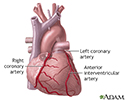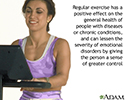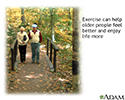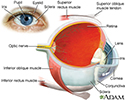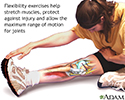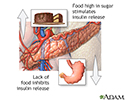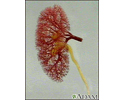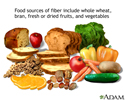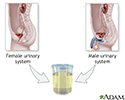Multimedia Gallery
Diabetes
Diabetes is on the rise worldwide, and is a serious, lifelong disease that can lead to heart disease, stroke, and lasting nerve, eye and foot problems. Let's talk about diabetes and the difference between the three types of diabetes.
So, what exactly is diabetes and where does it come from?
An organ in your body called the pancreas produces insulin, a hormone that controls the levels of your blood sugar. When you have too little insulin in your body, or when insulin doesn't work right in your body, you can have diabetes, the condition where you have abnormally high glucose or sugar levels in your blood.
Normally when you eat food, glucose enters your bloodstream. Glucose is your body's source of fuel. Your pancreas makes insulin to move glucose from your bloodstream into muscle, fat, and liver cells, where your body turns it into energy. People with diabetes have too much blood sugar because their body cannot move glucose into fat, liver, and muscle cells to be changed into and stored for energy.
There are three major types of diabetes. Type 1 diabetes happens when the body makes little or no insulin. It usually is diagnosed in children, teens, or young adults. But about 80% of people with diabetes have what's called Type 2 diabetes. This disease often occurs in middle adulthood, but young adults, teens, and now even children are now being diagnosed with it linked to high obesity rates. In Type 2 diabetes, your fat, liver, and muscle cells do not respond to insulin appropriately.
Another type of diabetes is called gestational diabetes. It's when high blood sugar develops during pregnancy in a woman who had not had diabetes beforehand. Gestational diabetes usually goes away after the baby is born. But, still pay attention. These women are at a higher risk of type 2 diabetes over the next 5 years without a change in lifestyle.
If you doctor suspects you have diabetes, you will probably have a hemoglobin A1c test. This is an average of your blood sugar levels over 3 months. You have pre-diabetes if your A1c is 5.7 to 6.4%. Anything at 6.5% or higher indicates you have diabetes.
Type 2 diabetes is a wake up call to focus on diet and exercise to try to control your blood sugar and prevent problems. If you do not control your blood sugar, you could develop eye problems, have problems with sores and infections in your feet, have high blood pressure and cholesterol problems, and have kidney, heart, and problems with other essential organs.
People with Type 1 diabetes need to take insulin every day, usually injected under the skin using a needle. Some people may be able to use a pump that delivers insulin to their body all the time.
People with Type 2 diabetes may be able to manage their blood sugar through diet and exercise. But if not, they will need to take one or more drugs to lower their blood sugar levels.
The good news is, people with any type of diabetes, who maintain good control over their blood sugar, cholesterol, and blood pressure, have a lower risk of kidney disease, eye disease, nervous system problems, heart attack, and stroke, and can live, a long and healthy life.
Diabetes
Review Date: 6/3/2025
Reviewed By: Ramin Fathi, MD, FAAD, Director, Phoenix Surgical Dermatology Group, Phoenix, AZ. Also reviewed by David C. Dugdale, MD, Medical Director, Brenda Conaway, Editorial Director, and the A.D.A.M. Editorial team.
Animations
- Blood pressure
- Bunion
- Cataract
- Childhood obesity
- Cholesterol and triglycerid...
- Coronary artery disease
- Depression
- Diabetes
- Diabetes - retinal conditions
- Diabetes and risk of seriou...
- Dialysis
- Erection problems
- Exercise
- Foot pain
- Gallstones
- Glaucoma
- Hardening of arteries
- HbA1c
- Healthy Guide to Fast Food
- Heart attack
- Hypertension
- Hypertension - overview
- Immune response
- Smoking
- Smoking tips to quit
- Stroke
- Stroke
- The goals of proper type 2 ...
- Tobacco use - effects on ar...
- Tracking your blood pressur...
- Type 1 diabetes
- Type 2 diabetes
- Understanding cholesterol r...
- Urinary incontinence
- Urinary tract infection - adults
- Vaccines
- Venous insufficiency
Illustrations
- 15/15 rule
- Abdominal girth measurement
- Abdominal muscles
- Acanthosis nigricans - close-up
- Acanthosis nigricans on the hand
- Acute MI
- Adjustable gastric banding
- Aerobic exercise
- Alpha-glucosidase inhibitors
- Angina
- Anterior heart arteries
- Atherosclerosis of the extr...
- Autonomic Nerves
- Baby bottle tooth decay
- Benefit of regular exercise
- Biguanides
- Blood pressure
- Blood pressure check
- Blood test
- Blood test
- Brain
- Brainstem function
- Calculating body frame size
- Candida - fluorescent stain
- Candidiasis, cutaneous - ar...
- Carotid dissection
- Carotid stenosis - X-ray of...
- Carpal tunnel syndrome
- Cataract - close-up of the eye
- Central nervous system
- Central nervous system and ...
- Cerebellum - function
- Childhood obesity
- Children's diets
- Cholesterol
- Cholesterol producers
- Circle of Willis
- Circulation of blood throug...
- Complex carbohydrates
- Coronary artery blockage
- Coronary artery disease
- Creatinine tests
- DASH diet
- Dermatitis - reaction to tinea
- Dermatitis - stasis on the leg
- Developmental process of at...
- Diabetes and exercise
- Diabetes and nerve damage
- Diabetes risk factors
- Diabetic blood circulation ...
- Diabetic emergency supplies
- Diabetic foot care
- Diabetic foot care
- Diabetic nephropathy
- Diabetic retinopathy
- Different types of weight gain
- Digestive system
- Endarterectomy
- Endocrine glands
- Energy levels
- Exercise - a powerful tool
- Exercise 30 minutes a day
- Exercise and age
- Exercise and heart rate
- Exercise can lower blood pr...
- Exercise with friends
- Eye
- Fast food
- Fasting plasma glucose test
- Female reproductive anatomy
- Female urinary tract
- Femoral nerve damage
- Fish in diet
- Flexibility exercise
- Follicle development
- Folliculitis - decalvans on...
- Folliculitis on the leg
- Food and insulin release
- Food label guide for candy
- Food label guide for whole ...
- Foot swelling
- Fruits and vegetables
- Fungus
- Gestational diabetes
- Gingivitis
- Gingivitis
- Glaucoma
- Glucose in blood
- Glucose test
- Granuloma - fungal (Majocchi's)
- Granuloma - fungal (Majocchi's)
- Granuloma annulare - close-up
- Granuloma annulare on the elbow
- Granuloma annulare on the eyelid
- Granuloma annulare on the legs
- Hair follicle anatomy
- Hammer toe
- Healthy diet
- Healthy diet
- Heart - front view
- Heart - section through the...
- Heart attack symptoms
- High blood pressure tests
- Influenza
- Influenza vaccines
- Ingrown toenail
- Insulin production and diabetes
- Insulin pump
- Insulin pump
- Islets of Langerhans
- Isometric exercise
- Jaw pain and heart attacks
- Kidney - blood and urine flow
- Kidney anatomy
- Kidneys
- Left cerebral hemisphere - ...
- Lifestyle changes
- Lipocytes (fat cells)
- Low blood sugar symptoms
- Male urinary system
- Male urinary tract
- Monitoring blood pressure
- myPlate
- Nail infection - candidal
- Necrobiosis lipoidica diabe...
- Necrobiosis lipoidica diabe...
- Nervous system
- Nervous system
- Normal uterine anatomy (cut...
- Obesity and health
- Omega-3 fatty acids
- Oral glucose tolerance test
- Osmolality test
- Pancreas
- Pancreas and kidneys
- Pelvic laparoscopy
- Pesticides and fruit
- Pharmacy options
- Physical activity - prevent...
- Pituitary and TSH
- Plaque buildup in arteries
- Pneumococcal vaccine
- Post myocardial infarction ...
- Posterior heart arteries
- Prevention of heart disease
- Progressive build-up of pla...
- Proteins
- Quitting smoking
- Radial nerve dysfunction
- Read food labels
- Retinal dye injection
- Right cerebral hemisphere -...
- Ringworm - tinea corporis o...
- Ringworm - tinea corporis o...
- Ringworm - tinea manuum on ...
- Ringworm - tinea on the han...
- Ringworm of the scalp
- Ringworm, tinea capitis - c...
- Roux-en-Y stomach surgery f...
- Salad nutrients
- Saturated fats
- Secondary infection
- Simple carbohydrates
- Slit-lamp exam
- Smoking hazards
- Sources of fiber
- Soy
- Stable angina
- Starchy foods
- Stein-Leventhal syndrome
- Stomach
- Stomach disease or trauma
- Stye
- Sulfonylureas drug
- Surface anatomy - normal palm
- Surface anatomy - normal wrist
- Swollen gums
- Thiazolidinediones
- Thyroid uptake test
- Tinea corporis - ear
- Tinea versicolor - close-up
- Tinea versicolor - close-up
- Tinea versicolor - shoulders
- Tinea versicolor on the back
- Tooth anatomy
- Tooth anatomy
- Trans fatty acids
- Type I diabetes
- Ulnar nerve damage
- Untreated hypertension
- Urine sample
- Uterus
- Vaginal discharge
- Visual field test
- Vitiligo
- Vitiligo - drug induced
- Vitiligo on the back and arm
- Vitiligo on the face
- Weight loss
- White nail syndrome
- Wood's lamp test - of the scalp
- Wrist anatomy
- Xerosis - close-up
- Yeast and mold
- Yeast infections
- Yoga
- Yo-yo dieting

 Bookmark
Bookmark















































